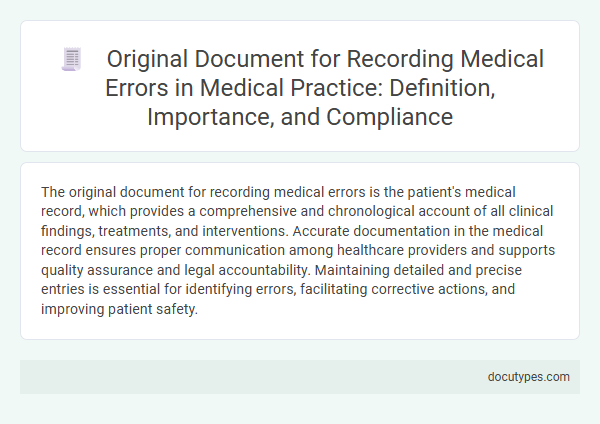The original document for recording medical errors is the patient's medical record, which provides a comprehensive and chronological account of all clinical findings, treatments, and interventions. Accurate documentation in the medical record ensures proper communication among healthcare providers and supports quality assurance and legal accountability. Maintaining detailed and precise entries is essential for identifying errors, facilitating corrective actions, and improving patient safety.
Introduction to Medical Error Documentation
Accurate documentation is crucial for managing medical errors effectively. The original document for recording medical errors serves as the foundational record for patient safety and quality improvement.
- Incident Report - The primary document used to record the details of a medical error immediately after it occurs.
- Patient Medical Record - Contains clinical notes and is updated to reflect any medical errors that impact patient care.
- Error Reporting Form - A standardized form used within healthcare institutions to collect detailed information on errors and near misses.
Proper documentation supports error analysis, risk management, and enhances healthcare delivery outcomes.
Defining the Original Medical Error Record
The original document for recording medical errors is the initial, official record created at the time the error is identified or discovered within a healthcare setting. This document captures detailed information about the error, including the nature, cause, and impact on patient care.
Defining the original medical error record involves understanding it as a primary source used by healthcare professionals for quality assurance and legal purposes. Your responsibility includes ensuring accuracy and completeness in this document to support effective error analysis and patient safety improvements.
Key Components of Medical Error Documentation
What is the original document used for recording medical errors? The original document for recording medical errors is typically the patient's medical record or chart. This record provides a detailed, chronological account of the patient's clinical care and any deviations or incidents encountered during treatment.
What are the key components of medical error documentation? Key components include a clear description of the error, the time and place it occurred, the personnel involved, and the immediate actions taken to address the error. Accurate documentation also contains the patient's response and any follow-up measures to prevent recurrence.
Legal and Regulatory Framework for Error Recording
The original document for recording medical errors is typically the patient's medical record, which serves as the primary legal evidence of care provided. Legal and regulatory frameworks mandate accurate and timely documentation to ensure accountability and support patient safety initiatives. You must adhere to these standards to maintain compliance and protect both patient rights and healthcare provider responsibilities.
Importance of Accurate Medical Error Records
| Aspect | Details |
|---|---|
| Original Document for Recording Medical Errors | The primary source is the Incident Report Form or Medical Error Reporting Form used within healthcare facilities to document errors during patient care. |
| Purpose of the Original Document | Captures detailed information about the nature, circumstances, and outcomes of medical errors for follow-up analysis and patient safety improvements. |
| Importance of Accurate Medical Error Records |
|
| Key Data Elements Recorded | Error type, time and location, personnel involved, patient impact, corrective actions taken, and follow-up measures. |
| Benefits of Maintaining Original Documentation | Ensures the integrity of medical error data, facilitates root cause analysis, and enhances institutional accountability. |
Impact of Documentation on Patient Safety
The original document for recording medical errors is typically the patient's medical record or chart. This record serves as the primary source of information for healthcare providers to track and address any issues that arise during treatment.
Accurate documentation of medical errors in the original record is crucial for enhancing patient safety and preventing future incidents. It allows healthcare professionals to analyze the underlying causes of errors and implement corrective measures. Your diligence in maintaining precise records directly contributes to safer care outcomes and improved clinical practices.
Compliance Standards in Medical Error Recording
The original document for recording medical errors is typically the patient's medical record, which serves as the primary source of accurate clinical data. Compliance standards, such as those set by The Joint Commission and HIPAA, require precise and timely documentation to ensure patient safety and legal accountability. You must adhere to these standards to maintain the integrity of medical error reporting and support quality improvement initiatives.
Challenges in Error Documentation Practices
Accurate documentation of medical errors is crucial for patient safety and healthcare improvement. The original document used for recording medical errors often faces several challenges that impact its reliability and effectiveness.
- Lack of Standardization - Variability in documentation formats and terminologies leads to inconsistent error reporting across healthcare institutions.
- Incomplete or Inaccurate Entries - Time constraints and fear of blame contribute to underreporting or omission of critical error details in original records.
- Legal and Confidentiality Concerns - Healthcare providers may hesitate to fully document errors due to potential legal repercussions and patient privacy issues.
Strategies to Improve Medical Error Recording
The original document for recording medical errors is typically the patient's medical record or chart. This document serves as the primary source for documenting all aspects of patient care, including any mistakes or adverse events.
Strategies to improve medical error recording include implementing standardized error reporting forms within electronic health records (EHR). Encouraging a non-punitive culture where healthcare professionals feel safe to report errors enhances accuracy and completeness in documentation.
What Is the Original Document for Recording Medical Errors? Infographic

